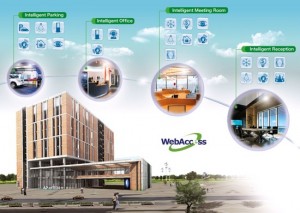As economies adjust to ever-rising demand for and costs of energy, an increasing range of enterprises are focusing on intelligent-building strategies. Globally, commercial buildings currently consume just fewer than 25 percent of all electricity production, making intelligent, automated management of those resources critical not only to enterprise efficiency, but also to global energy-allocation challenges.
While energy exigencies may explain, in large part, the “why” of the growing emphasis on intelligent-building design, the “how” is increasingly influenced by trends that emphasize converging building-control and -data systems into enterprise information-technology systems, whether as dedicated or fully integrated networks, sharing infrastructure and protocols with ubiquitous IT systems. Meanwhile, intelligent-building and building-management systems are succumbing to the same interoperability pressures that I discussed in a previous blog entry, while programmable logic controllers give way to distributed-intelligence microprocessors.
The Industrial Arena utilizes Intelligent Building because it provides immediate ROI due to an increase in employee productivity and reduction operating expenses. When designing an Intelligent Building, it’s necessary to create an optimal product and not sacrifice quality due to cost associated with the project.
Intelligent Buildings address the following aspects of automation:
- Integrated and Intelligent Systems; which include fire protection, voice communication, security & access control, car parking & ticketing and industrial control & instrumentation
- Energy Management System & Services; which involves energy audits, conservation studies, overall plant performance, energy savings findings and implementation of energy-saving practices
- Service Support & Maintenance; which will address maintenance and facility contracts, monitoring and management
At the end of the day, how can a manufacturer accomplish the tasks listed above?
The one clear answer I have is Advantech’s intelligent building solution (AiBS) software: WebAccess.
WebAccess is a graphical control SCADA/HMI software package providing remote control and management functions, a front-end platform and a user-friendly interface to configure, operate, maintain and manage the entire system.
WebAccess is centered on intelligent parking, reception, office, meeting room and security with the added feasibility of configuring additional and required applications. In addition, WebAccess has drivers for close to 100 different brands of equipment and devices utilized for electricity, AC, lighting, fire emergency, access control, video, audio and more. The most appealing aspect of WebAccess is that everything can be integrated into a single platform, which is a big plus from a compatibility perspective. The support of Draw & View based on HTML5 to assist in displays on operating systems including Windows, iOS and Android is also a huge plus.
With WebAccess, cloud services and an array of hardware designed to acquire critical data, display for user interface and make determinations based on outcomes, Advantech has established a reliable Intelligent Building solution.
Subsystems, once treated as isolated functions and automated, if at all, by standalone devices such as smart thermostats, are now recognized by the most successful intelligent-building designs as highly interrelated aspects of comprehensive automation strategies.
Because major renovations of commercial buildings are typically undertaken only every 25 years or so, intelligent-building systems must be readily expansible and upgradable as usages and technologies evolve during these between-retrofit periods.
The most successful intelligent-building systems are those that were designed with sufficient flexibility to accommodate and take advantage of that rapidly-developing trend. Intelligent-building systems must, therefore, be both comprehensive enough to address all critical subsystems yet flexible enough for expansion to address new subsystems and emerging technologies.














